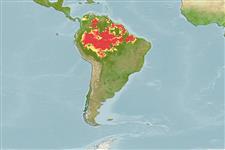| Native range | All suitable habitat |

|
| This map was computer-generated and has not yet been reviewed. |
| Astronotus ocellatus AquaMaps Data sources: GBIF OBIS |
Length at first maturity
Lm 12.0 range ? - ? cm
Human uses
Fisheries: commercial; gamefish: yes; aquarium: highly commercial
Phylogenetic diversity index
(Ref. 82805)
PD50 = 0.7500 many relatives (e.g. carps) 0.5 - 2.0 few relatives (e.g. lungfishes)
Trophic Level
(Ref. 69278)
2.8 ±0.32 se; Based on food items.
Resilience
(Ref. 69278)
High, minimum population doubling time less than 15 months (Assuming tm<=1; Fec=300-2000)